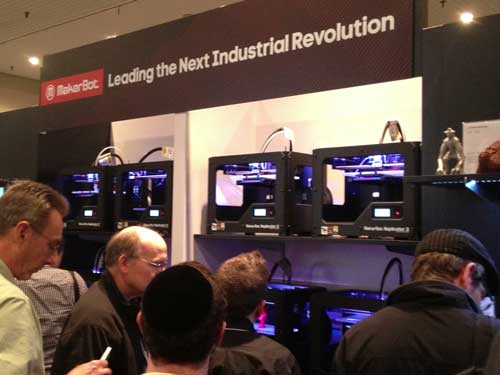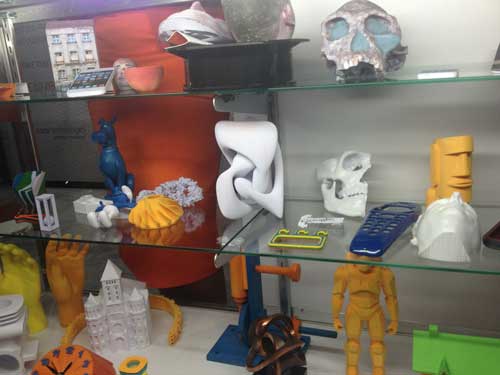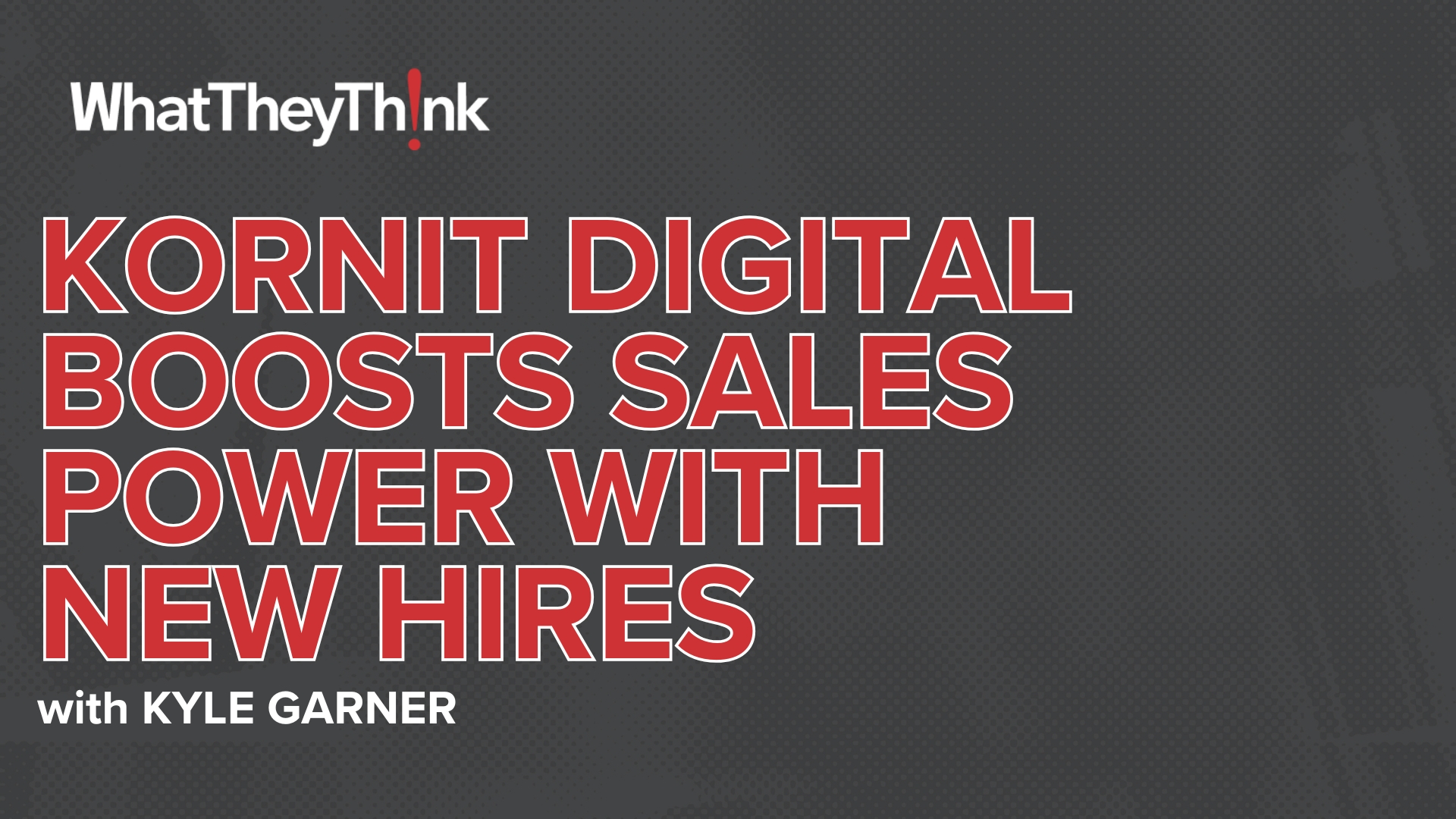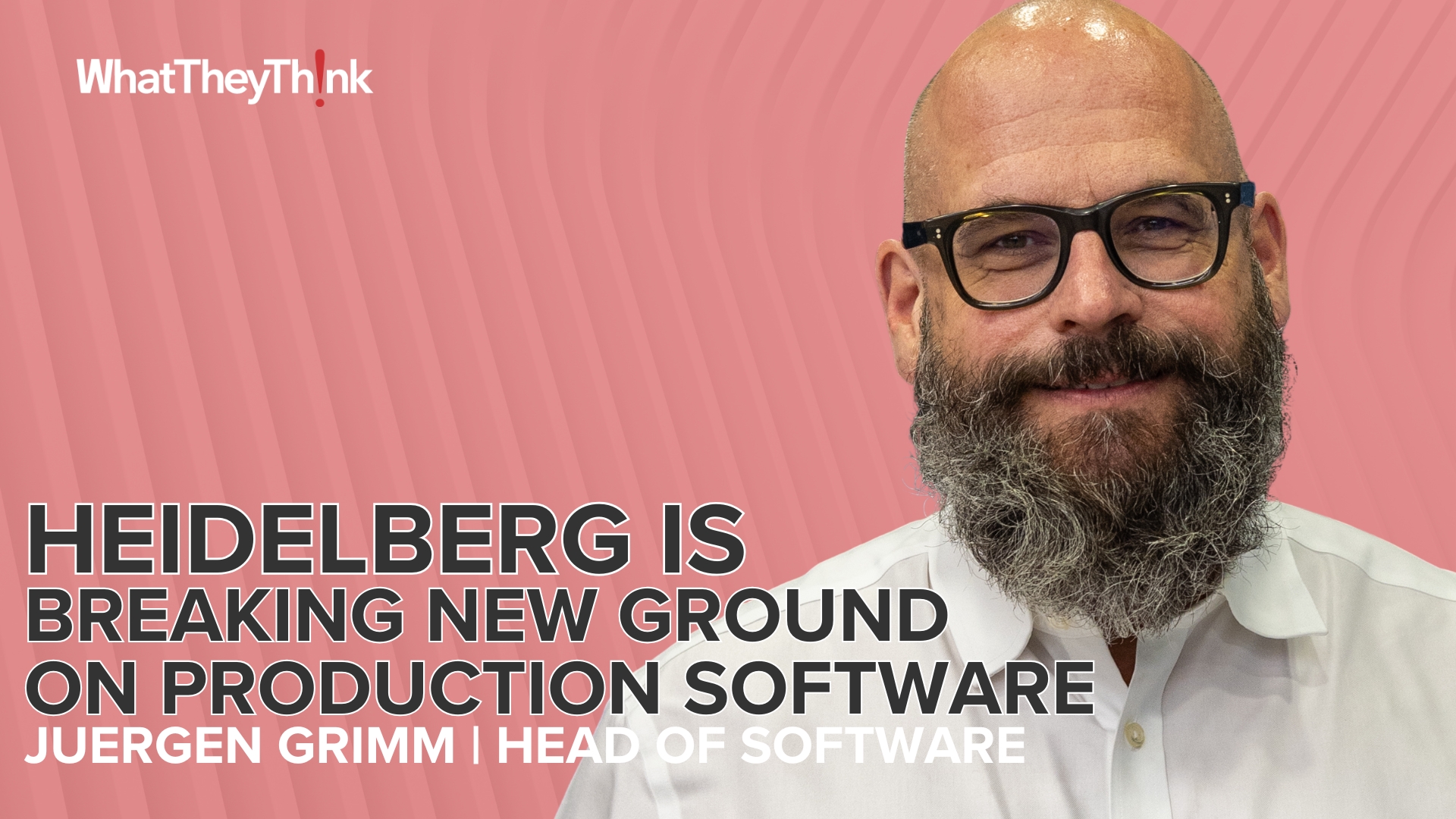In 1884, the English schoolmaster Edwin A. Abbott published a geometrical fantasy he called Flatland: A Romance of Many Dimensions. “Imagine a vast sheet of paper on which straight Lines, Triangles, Squares, Pentagons, Hexagons, and other figures, instead of remaining fixed in their places, move freely about, on or in the surface, but without the power of rising above or sinking below it,” wrote Abbott of what life in this prohibitively planar world would be like. “In such a country, you will perceive at once that it is impossible that there should be anything of what you call a ‘solid’ kind.”

Like the Flatlanders, those of us grounded in conventional graphic reproduction may have trouble imagining that anything calling itself “printing” could be done in more dimensions than two. But, 3D printing exists in a palpable world of its own, and as a focus of popular and business interest, it has a rising profile that fans of the process literally can reach out and touch.
And now, it also has its own trade show: the Inside 3D Printing Conference & Expo, an event that drew about 2,500 attendees to the Jacob K. Javits Convention Center in New York City on April 22 and 23. The program assessed 3D printing both as a technology and as an investment opportunity, emphasizing its broad range of applications for manufacturing, science, education, fashion, the arts, and even the preparation of food (as elaborated by the session titled “Digital Cuisine: Bringing 3D Printing to the Cooking Realm”).
The mostly pipe-and-drape exhibit area was tiny by the standards of conventional print trade shows, but it was packed with solutions that propose to carry 3D printing into mainstream acceptance. These included tabletop 3D printers that hobbyists can purchase for a few hundred dollars as well as more complex and costly systems for industrial-strength prototyping and fabrication.

Our search for areas of crossover between 3D printing and the ink-on-paper kind didn’t locate much common ground. However, one or two of the 3D applications we looked at seemed to hold potential for conventional print providers. What’s more, the two processes do share a few analogous technical characteristics, suggesting that the conceptual gap between them may not be too wide for adventurous 2D print practitioners to cross.
In an opening-day keynote address, the head of the event’s premier exhibitor described forces that he said are converging to bring 3D printing into its own as a disruptive and transformative technology. Avi Reichental, president and CEO of 3D Systems, predicted that 3D printing would “integrate and mimic the success of the machine tool industry” as it finds work to do in industrial processes of all kinds.
The demand for highly complex components from sectors such as aerospace and automotive will be one of the drivers for 3D printing’s adoption, according to Reichental. So will the market for “patient specific medical devices,” including hearing aids and dental implants, that let patients “celebrate their restorations” with prostheses exactly matching their conditions and requirements. 3D printing is the only manufacturing technique capable of producing ultra-personalized items like these, noted Reichental.
In retail stores, he said, 3D printing systems will let consumers “co-create with their favorite brands” as they invest “emotional equity” in specialty products designed and produced on demand, just for them. Education and fashion are other areas where 3D printing can discover exceptional opportunities, according to Reichental.
He cautioned that as widespread 3D printing brings about “the unimagined, the unintended, and the unleashed,” some of the consequences will be undesirable: counterfeiting, for example, or the illicit manufacture of gun parts. “We cannot be in denial about what’s possible,” said Reichental, calling upon the 3D printing industry and lawmakers to think proactively about safeguarding the technology from misuse.
Given that 3D printing was invented more than 30 years ago—about the same time that desktop publishing systems were making their first inroads into the printing industry—the impact that Reichental described has been a long time in coming. Another speaker, Brian Evans, in a tutorial on desktop 3D printing systems, cast these devices in the same revolutionary role today that desktop publishing systems occupied when they began transforming graphic reproduction in the mid-1980s.
Evans, an artist, a blogger, and an assistant professor of art at Metropolitan State University of Denver, stressed that desktop 3D printing systems are “the dot matrix printers of the 3D world” and that as such, they are limited in what they can do. Even so, he said, when he briefed a class about Cupcake, a breakthrough desktop unit released by MakerBot in 2009, “I told my students that this was their Apple I moment.”
Now available for home, school, and office use, said Evans, are 3D desktop printers ranging in price from about $400 to $3,000. Some come in kit form, while others, according to their manufacturers, can be ready to print within minutes of taking them out of the box. Despite the machines’ limitations, said Evans, “the technology is pretty darn reliable—for what it is, it’s really reliable.”
As Evans described them, desktop 3D printing systems are tools for additive manufacturing: a technique that, starting from nothing, creates things by building up successive increments of material into a finished whole. Its opposite, subtractive manufacturing, cuts, carves, lathes, or otherwise removes the excess from an initial quantity of raw matter, leaving behind not only the desired object but also a volume of waste.
Most 3D printing systems have either fused deposition modeling (FDM) or stereolithography (SLA) as their underlying technology. FDM units, more frequently seen on the desktop than SLA devices, melt plastic from a spool of filament and feed it into the printing head for layer-by-layer extrusion. SLA, the older of the two processes, focuses a laser on a bath of liquid, light-sensitive photopolymer. The laser traces and hardens the initial layer, which is then plunged back into the photopolymer so that the next layer can be formed on top of it.
Plastics are far from being the only substances suitable for 3D printing. There also are applications for powdered metal and glass, pharmaceutical ingredients, chocolate, and other foodstuffs. Mcor Technologies Ltd. has come up with a way to let its 3D printers use ordinary business and letter papers as the build material.
Medical science has used 3D-printable biomaterials to generate replacements for human bones and skin. Researchers are experimenting with 3D printing systems that they say will enable them to manufacture fully functioning internal organs such as kidneys and gall bladders from an input of stem cells. In Australia, surgeons recently gave a 3D-printed prosthetic “face” made of synthetic materials to a patient whose own face had been terribly ravaged by a tennis-ball-sized tumor.
Needless to say, the production workflow that makes these miracles possible is entirely computer controlled. The first step is to create a three-dimensional CAD file of the object to be printed. This design is then imported into a Gcode generator—software that “slices” the CAD file into printable layers that the output unit will be directed to create.
If this routine sounds a bit like raster image processing for conventional print, it isn't the only oddly familiar carryover from 2D printing to be found in the 3D realm. For example, the quality of a 3D-printed surface depends on how thin a layer the device can produce: the finer the layering, the better the look and feel, much like the relationship between high dpi and high resolution in 2D print. Just as some images for 2D print are made of pixels, the 3D process defines printable space in voxels (volumetric picture elements). As might be expected, 3D printing also has its own alphabet soup of file-format abbreviations.
The near-similarities don’t end there. Like conventional presses, 3D systems can print multiple up in whatever number of units their build platforms (image-forming surfaces) are spacious enough to accommodate. Isopropyl alcohol, once widely used in lithographic dampening systems, turns up in 3D printing both as a rinse for removing excess resin from SLA-formed prints and as a cleaner for build platforms and printheads.
Those who remember handling litho films and plates in yellow safelight would have recognized that ambient color right away in the Form 1, a desktop 3D printer on display at the Formlabs stand during Inside 3D Printing. In prep departments, yellow safelight protects media from accidental exposure. The Form 1’s transparent amber hood contains the emissions of the SLA printing unit’s UV laser within the device while blocking external UV—accomplishing essentially the same thing.
The event’s exhibit area showed the principles of 3D printing in practice, with several of the stands featuring desktop and industrial machines in live operation. Many of the specimens being produced were art objects and decorative pieces, prompting speculation on our part that 3D printing might make an attractive sideline for quick printers and other graphics businesses that deal in advertising specialty items.
Attractive, that is, with a qualifier. Although 3D printing is said to be scalable, it isn't capable of mass production. And, as a manufacturing process, it operates at about the same apparent pace as paint drying on a wall. This means that the quick-print shop that installs a desktop 3D unit can’t suddenly cease doing business with its promotional products supplier if its trade in these items is good and it wants to keep up with demand.
The opportunity could lie in producing bespoke, ultra-customized pieces at premium prices—one-of-a-kind keepsakes available from no other source. Thingiverse, MakerBot’s online trading post for 3D printing source files, contains examples of some of the intricate forms that these high-end specialty items might take.
Besides the production hardware it brought to its stand, 3D Systems presented something that linked 3D printing to the most frequently reproduced type of graphic image: personal photography. This was 3DMe, a service that invites consumers to upload head shots to a cloud where their faces are grafted onto design files for 3D-printed “figurines”: 5.5" plastic action figures available in a variety of fantasy costumes and professional attires. The made-to-order mini-mes, which cost $64.99, can be further personalized with messages imprinted across the base.
While we were looking 3DMe over, a professional photographer standing nearby wondered aloud about how he might apply a solution like this to his wedding business—imagine, for example, not generic likenesses but spitting images of the bride and groom crowning the cake. Perhaps conventional graphics firms rooted in photo printing should be taking the same kind of interest in the potential applications of 3D technologies to the image-replicating businesses they are in.
3D Systems wasn't the only exhibitor providing an e-commerce alternative for those who may not be inclined to do the printing themselves. Sculpteo, for example, sells 3D-printed iPhone cases and other items through an app. It also prints uploaded files to order and offers a cloud-based, on-demand manufacturing service for businesses that want to break into the 3D printing market without the up-front investment. Billing itself as “your virtual desktop 3D printer,” ZoomRP operates a rapid-response prototyping service that can turn jobs around overnight.
All in all, the Inside 3D Printing event lent credibility to a forecast from the Consumer Electronics Association that the global market for 3D printing equipment and services could be nearly $5 billion by 2017. But, for the prediction to come true, some barriers to the mass market’s embrace of this still relatively unfamiliar technology and its products will have to be removed.
At a stand displaying a line of small-footprint, low-cost 3D printers, the exhibiting company’s president said that a retail breakthrough will not happen until a “killer app”—a 3D-printed item that takes the consumer marketplace by storm—makes its appearance. He was confident, though, that as more artists and other creatives learn to express themselves in the new medium that 3D printing represents, that game-changing object of desire will not be slow in arriving.
Inside 3D Printing was produced by WebMediaBrands, owner of the Mediabistro job board and other properties for media networking and education. Those who couldn't attend the inaugural edition of Inside 3D Printing in New York can catch it on the road in Chicago (July 10-11) and San Jose (September 17-18). International editions will be held in Singapore and Munich.
3D printing also is gaining a high profile in academia as more schools install the devices for research and student use. At Inside 3D Printing, we learned that ConFABulation, a one-day symposium focused on incorporating 3D scanning, modeling, animation, digital fabrication, and 3D printing into the classroom, will take place at Prince George's Community College (Largo, MD) on June 5th. More information is available here.















Discussion
By Chuck Gehman on Apr 29, 2013
Fascinating and good coverage.
However, I think you should start a new website, called "Whattheythink about Making", and talk about this over there.
This has virtually nothing to do with the world that printers live in today. If "becoming a marketing service provider" is a trip to the moon, this is a trip to Mars or even beyond.
By Robert Arena on Apr 29, 2013
Chuck, I can not believe you said that being the forward thinking guy you are. Isn’t that the point of WhatTheyThink, to get us to think of the world we are going to live in, allowing us to be proactive?
By Patrick Henry on Apr 29, 2013
Thanks for the comments, Robert and Chuck. I am hoping that other readers also will jump in with opinions about how--or even if--3D printing intersects with the 2D printing businesses that most WhatTheyThink readers make their livings at. It's a wide-open question, and I am far from having any answers.
By Chuck Gehman on Apr 29, 2013
Robert, don't think I have a closed mind about this technology. It's awesome. But Printers need to keep it real. I think this is a distraction from what printers can and should be focusing on.
While I think there may be some printers who could succeed with this, I think that it's a tiny fraction of the community.
How many PSPs do CAD output? That would require lesser skills than this. Of those that do that output, how many would open and manipulate a file in AutoCad, 3DS or Solidworks? That is simply not part of the skill sets that are present in PSP companies. It would require complete re-education to acquire and then requiring competing against companies who have better DNA.
You want to compete with this? http://www.shapeways.com/
Actually, please do. And leave the "real" printing to us!
3D Printing is printing in name only. It's actually CAD/CAM. Using the term printing just makes it seem "friendlier".
By rick ciordia on Apr 29, 2013
Terrific coverage on an emerging technology. While this technology has its roots in CAD, I believe it is relevant to today's printers who are looking at different ways to expand their business in the future.
While the bulk of the initial push has been toward manufacturing and prototyping, Staples has made a deal to put these types of machines into a limited amount of stores over the next year or so as a test.
I was also at a graphic arts dealers open house in Nashville, TN in Feb and they were displaying a desktop 3D device to the printers who attended.
Obviously this is not yet ready for prime time and early adopters may have issues with both the niche and the learning curve, but make no mistake, it can, should and will be incorporated into our world of....printing.
By Andrew Gordon on May 01, 2013
Patrick, this is really well written. Thank you for sharing this with our community. We are lost as an industry if we think that adding yet another product line will do the trick. If however, the focus is on adding value to vertically integrated solutions, then 3D printing could be a great fit. I can certainly envision a service provider that focuses on the AEC market that provides marketing services, pitch books, blueprint output, and 3D prototypes. I can also envision a service provider that focuses on B2C photo premiums, who also offers 3D figurines. I can envision a service provider who specializes advertising premiums, using 3D printing to offer a prototyping option to design custom premiums. Even more unique, I can certainly imagine a service provider who focuses on loyalty programs, offering clients the ability to deliver personalized keepsakes to loyal customers. Otherwise, there are plenty of specialized service providers who are already experts in scanning, manipulating CAD files, and generating 3D printed objects. My hope is that our industry continues to push forward with value-added solution sets that embrace a range of technology solutions to deliver value to customers.
By Pete Basiliere on May 02, 2013
The roots of 3D printing are actually in "additive manufacturing." Most of us are familiar with "subtractive manufacturing" where a block of metal is carved away to create the finished part. The term "3D printing" came into widespread use over the last five years, basically supplanting the "AM" term although additive manufacturing better describes the seven different technologies currently used to build items layer by layer.
That said, as someone who has 35 years worth of ink and toner in his veins, my coverage of 3D printing for the last 5 years led me to the conclusion that there already is a place for 3D printing services within the 2D printing industry along the lines that Andy suggests.
To Chuck's point, 3D printing is not something the majority of WTT's readers will want to engage in - today. But pieces such as Patrick's alert "print service providers" to another technology - another service - that PSPs must monitor and may one day offer.